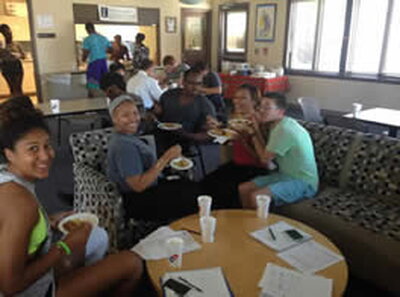
Ercan Balci, Director of the Less Commonly Taught Languages Program
The summer 2014 institute offered three languages that attracted adequate enrollments: Arabic, Swahili, and Turkish with 38 students during summer 2A and 32 students during summer 2B. In addition to adding instructors, we hired tutors for each of our languages who performed some extra-curricular tasks and provided additional assistance to our students.
We started our publicity efforts during fall 2013. The pre-SILMW 2014 planning phase concluded with a half-day-extensive Teachers’ Training Workshop on June 13 and a students’ orientation on Monday morning, June 16. The instructor workshop focused on key aspects of language teaching, and learning, including teaching methods, SLA theories that inform current teaching methods, syllabus construction, teaching practice by the instructors, and presentation and constructive criticisms of syllabi for each of the courses.

A co-teaching model was adopted this year in SILMW. This meant that two instructors were assigned to teach during the 8-week summer session. There were two distinct models in which two instructors collaborated for the entirety of the eight-week session with one instructor teaching in the morning session and the other in the afternoon. Instructors alternated their teaching schedule weekly. In the second model, one instructor was present during the first four weeks and completed one course with the students and the other started in the beginning of the second course. Instructors of the Swahili courses followed the first model and Arabic instructors followed the second model. A total of six instructors (2 for Swahili and 4 for Arabic) were involved in this process in SILMW 14.
SILMW 2014 opened for instruction on June 16 with the students’ orientation and ran until August 8 for a total of eight weeks. As in the previous SILMWs, the curricular program was intensive in that Elementary level (201/202) met for 4 hours daily, 5 days per week; Intermediate level (403 & 404) courses met 4 hours daily for 4 days and 2 hours on Fridays; whereas the advanced level (405/406; 407/408) courses met for 4 hours per day, 4 days per week. Language courses at all levels were taught in the target language, with Elementary Arabic, which has a non-Latin script, moving gradually under this approach during the first week or so of instruction so as to immerse the students almost totally in their language by the end of the 2nd week. Similarly, language classes were complemented by a variety of extra-curricular activities as discussed above. This rich array of activities permitted students from the different classes learning different languages to gain some cultural insights, and to meet and interact with their colleagues.
Pursuant to previous SILMWs, a series of extra-curricular activities was planned, staring in the spring semester, by the Director and the GA. These included weekly Research Forums, language-specific film screenings, local field trips, ethnic cuisine cooking demonstration lessons, a picnic and Iftar dinner, and conversation table sessions for each language or language level. Once classes began, these activities were posted on the SILMW blogger, and updated weekly by a graduate student, who was appointed effectively after May 15 as a GA, with reminder e-mails periodically sent to the students.
The most important extra-curricular activity which all the students, their guests, instructors, and their families attended was the Language Showcase Festival which was held on July 31st, 2014 at the Illini Union. This event consisted of three parts: (1) A presentation about the SILMW 2014; short speeches by the Director, the Associate Director, and the Department Head; and reflections from a student and instructor representative; (2) Students’ performances where they showcased how much language they learned during the Institute; and (3) A buffet style dinner accompanied with music and a slideshow of the students and instructors attending and engaging in extra-curricular activities. This signature event was the highlight of the institute. The preparations for the performances started in the third week of the institute with students and instructors brainstorming the topic and the content of the performance. Instructors submitted the synopses of the skits on July 22 to be included in the program, and on July 29, the students performed a formal rehearsal during which the Director gave feedback to the students and the instructors. Considering the feedback from different sources after the event, I can confidently say that the showcase was a success, and the students, guests, and instructors enjoyed this event.
The conclusion of SILMW 2014 offered us yet another lesson on possible best practices. The most important of these from an operational perspective was the necessity to work closely with all stakeholders on campus to ensure a smooth operation, or at least avoid challenges, and to begin the planning for the next year’s Institute at the earliest time possible. SILMW 2015 will take place under the leadership of Dr. Eman Saadah between June 15 and August 8, 2015. Check out our new website for details: www.silmw.linguistics.illinois.edu and plan to take one of our offerings: Arabic, Persian, Swahili, Turkish, Urdu, Uzbek, or Wolof.